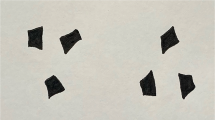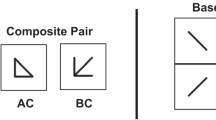Abstract
The apparent line-like structure in dot patterns derives substantially from the orientation defined by pairings of adjacent dots. Two alternative models have been proposed for making these pairings, one in which the individual dots are treated as discrete grouping tokens, and the second in which the pairing orientation derives from spatial summation by simple cell receptive fields. Contradictory evidence has been found both directly in support of, and directly against, both models. Much of the debate about these two models has hinged on the degree of linearity of summation expected in the simple cell model. Recent neurophysiological evidence changes the balance of the debate, invalidating certain earlier arguments based on linearity and providing a novel way of showing that simple cells do indeed play a major, but not necessarily exclusive, role in dot groupings.
Similar content being viewed by others
References
Attneave F (1955) Perception of place in a circular field. Am J Psychol 68:69–82
Attneave F (1974) Apparent movement and the what-where connection. Psychologia 17:108–120
Beck J, Halloran T (1985) Effects of spatial separation and retinal eccentricity on two-dot vernier acuity. Vision Res 25:1105–1111
Bishop PO, Henry GH (1972) Striate neurones: receptive field concepts. Invest Ophthalmol 11:346–355
Bishop PO, Coombs JS, Henry GH (1971) Responses to visual contours: spatio-temporal aspects of excitation in the receptive fields of simple striate neurones. J Physiol 219:626–657
Caelli TM, Julesz B (1978) On perceptual analyzers underlying visual texture discrimination: Part I. Biol Cybern 28:167–175
Caelli TM, Preston GAN, Howell ER (1978) Implications of spatial summation models for processes of contour perception: a geometric perspective. Vision Res 18:723–734
Carlson CR, Anderson CH, Moeller JR (1980) Visual illusions without low spatial frequencies. Invest Opthalmol Vis Sci [Suppl] 19:165
Daugman JG (1985) Uncertainty relation for resolution in space, spatial frequency, and orientation optimized by two-dimensional visual cortical filters. J Opt Soc Am 2:1160–1169
Ginsberg AP (1973) Pattern recognition techniques suggested from psychological correlates of a model of the human visual system. 1973 IEEE Trans Aerospace Electron 9:625–635
Glass L (1969) Moire effect from random dots. Nature 223:578–580
Glass L (1979) Physiological mechanisms for the perception of random dot moire patterns. In: Haken H (ed) Pattern formation by dynamic systems and pattern recognition. Springer, Berlin Heidelberg New York
Glass L, Perez (1973) Perception of random dot interference patterns. Nature 246:360–362
Glass L, Switkes E (1976) Pattern recognition in humans: correlations which cannot be perceived. Perception 5:67–72
Hammond P, MacKay DM (1983a) Influence of luminance gradient reversal on simple cells in feline striate cortex. J Physiol 337:69–87
Hammond P, MacKay DM (1983b) Effects of luminance gradient reversal on complex cells in cat striate cortex. Exp Brain Res 49:453–456
Hammond P, MacKay DM (1985) Influence of luminance gradient reversal on complex cells in feline striate cortex. J Physiol 359:315–329
Heggelund P, Kreklong S, Skottun B (1983) Spatial summation in the receptive field of simple cells in the cat striate cortex. Exp Brain Res 52:87–98
Henry GH, Goodwin AW, Bishop PO (1978) Spatial summation of responses in receptive fields of single cells in cat striate cortex. Exp Brain Res 32:245–266
Hubel DH, Wiesel TN (1962) Receptive fields, binocular interaction and functional architecture in the cat's visual cortex. J Physiol 160:106–154
Janez L (1984) Visual grouping without low spatial frequencies. Vision Res 24:271–274
Julesz B (1981) Figure and ground perception in briefly presented isodipole textures. In: Kubovy M, Pomerantz JR (eds) Perceptual organization. Lawrence Erlbaum, Hillsdale, NJ, pp 27–54
Koehler W (1929) Gestalt phsychology. Liveright, New York
Koffka K (1935) Principles of Gestalt psychology. Harcourt, Brace, New York
Lulich DP, Stevens KA (1989) Differential contributions of circular and elongated spatial filters to the Café wall illusion. Biol Cybern 61:427–435
Maloney RK, Mitchison GJ, Barlow HB (1987) Limit to the detection of Glass patterns in the presence of noise. J Opt Soc Am A 4:2336–2341
Marr D (1976) Early processing of visual information. Phil Trans R Soc Lond B 275:483–524
Marr D (1982) Vision: a computational investigation into the human representation and processing of visual information. Freeman, San Francisco
Marr D, Poggio T, Hildreth E (1980) Smallest channel in early human vision. J Opt Soc Am 70:868–870
Movshon JA, Thompson ID, Tolhurst DJ (1978) Spatial summation in the receptive fields of simple cells in the cat's striate cortex. J Physiol 283:53–77
Prazdny K (1984) On the perception of Glass patterns. Perception 13:469–478
Prazdny K (1986) Some new phenomena in the perception of Glass patterns. Biol Cybern 53:153–158
Smits JTS, Vos PG (1986) A model for the perception of curves in dot figures: the role of local salience of virtual lines. Biol Cybern 54:407–416
Stevens KA (1978) Computation of locally parallel structure. Biol Cybern 29:19–28
Stevens KA, Brookes A (1987) Detecting structure by symbolic constructions on tokens. Comput Vision Graph Image Process 37:238–260
Ullman S (1979) The interpretation of visual motion. MIT Press Cambridge, Mass
Webster MW, De Valois RL (1958) Relationship between spatial-frequency and orientation tuning of striate-cortex cells. J Opt Soc Am 2:1124–1132
Wertheimer M (1923) Untersuchungen zur Lehre von der Gestalt. Psych. Forsch 4:301–350. Cited in: Beardslee DC, Wertheimer M (eds) Readings in perception. Van Nostrand, New York
Zucker SW (1983) Computational and psychophysical experiments in grouping: early orientation selection. In: Beck J, Hope B, Roseneld A (eds) Human and machine vision, pp 545–567
Author information
Authors and Affiliations
Additional information
The research reported in this article was supported by Air Force Office of Scientific Research contract number F49720-83-C-0093 and Office of Naval Research Contract number N00014-87-K-0321
Rights and permissions
About this article
Cite this article
Brookes, A., Stevens, K.A. Symbolic grouping versus simple cell models. Biol. Cybern. 65, 375–380 (1991). https://doi.org/10.1007/BF00216971
Received:
Accepted:
Issue Date:
DOI: https://doi.org/10.1007/BF00216971




